Foolish Mortals review
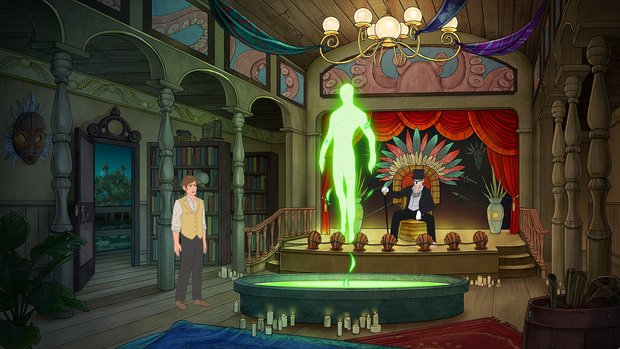
- 12 Comments
No mere ghostly apparition – a modern classic has materialized
Think back to the first time you ever played through your favorite 2D point-and-click adventure from start to finish. What was it that made you fall in love with that game? Maybe it was the characters and the fantastical world you got lost in. Or perhaps the clever puzzles challenged you to think outside the box with an unparalleled sense of accomplishment upon coming to a solution. For me, that game was Monkey Island 2: LeChuck’s Revenge. While I love many of the titles I’ve played in the years since then, Guybrush Threepwood’s second adventure has always stood in a class of its own in my mind, and a shining example of what I adore in this genre. Now, however, with Inklingwood Studios’ Foolish Mortals, that class has expanded. Incredibly for a first-time developer, the love and passion for what makes a great adventure game is deeply understood and refined here to perfection, and any adventurer – whether new to pointing-and-clicking or veterans who’ve stuck with it since their first outing as Sir Graham – owes it to themselves to make haste to Bellemore Manor.
The story begins with Murphy McCallan arriving at the mysterious island of Devil’s Rock off the coast of Louisiana in the year 1933. Officially, he’s here as an auditor working to recover the debts of the Bellemore Trading Company that are many years past due. Personally, he’s motivated by a pulp magazine story about the history of the Bellemore Manor, a secret thirteen-million-dollar treasure believed to be hidden somewhere on the premises, and how 33 years ago everyone disappeared without a trace on the wedding night of the family heir, Abigail. Murphy’s had dreams of the old mansion every night since reading about it, and after digging up the account details from the archives at the company he works for, he set off for the island to figure out the mystery of the fabled secret fortune himself.
A troubled voyage delayed Murphy’s arrival to meet comptroller Theodore Grimes, however, and by the time he gets to Devil’s Rock there’s a problem: Theodore Grimes is now the late Theodore Grimes, so the one lead Murphy had to discover the truth is gone forever. Or so he thinks. He’s quickly advised to seek out the “Spirit Queen,” and with this new clue Murphy departs for the nearby town of Deadnettle, where his perilous quest to unravel the matter of the missing treasure begins, all in a single night, heedless of the many warnings that the Bellmore Manor is now haunted.
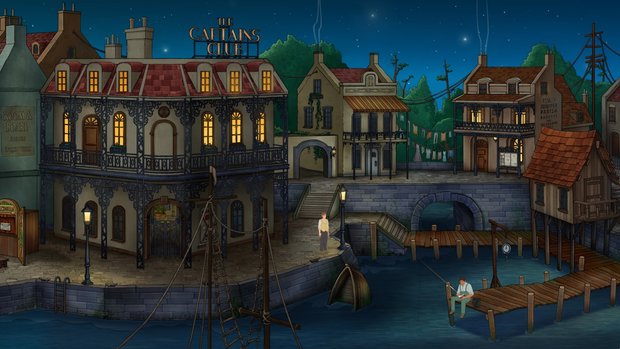
In time, Murphy will uncover a dangerous secret locked far away from prying eyes in the shadowy past of the Bellemores and make a powerful enemy who will stop at nothing to beat him to the truth. The layers of a supernatural mystery slowly peel themselves back as you continue delving deeper, but it’s not all doom and gloom in this world of dark magic and frights. As advertised, the tone is always balanced between the “merry & macabre” – ghosts play jazz music, drink rum, and tend the local conservatory of horrifically deadly poisonous plants (as every self-respecting manor home should have). After all, what’s the point of being dead if you’re not living a spirited afterlife?
Your journey is accompanied by one of the best soundtracks of recent memory – not just in adventure games, but games in general. The compositions are both eerie and dramatic, swaying with massive crescendos when the need arises or softly twinkling in a moment of mystery. This is a truly cinematic experience, elevated even further by stunning still paintings during plot narrations of major parts of the story. Other moments have dramatic zoomed-in shots of characters speaking or different perspectives of locations in the environment.
The visuals overall are every bit as good as the soundtrack, as Foolish Mortals is easily one of the most gorgeous 2D animated adventures I’ve ever played – either classic or modern. The art style is something between The Curse of Monkey Island and Broken Sword: Shadows of the Templars, with characters fully animated against equally beautiful hand-drawn backgrounds. They’re all meticulously detailed, such as the eerie grounds of Bellemore Manor with its visible decay on the exterior from years of neglect, or the crashing waves on the rocky shore of Causeway Beach where Murphy first arrives on Devil’s Rock.
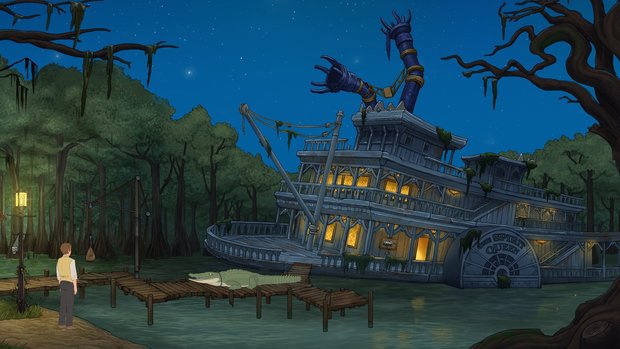
Every location fits cohesively into the delightfully murky world of an island off the coast of Louisiana. One location deep in the bayou houses a luxurious riverboat that ran aground ages ago, with a curious new benefactor residing within its walls. Away from the island’s run-down chapel lies a creepy old cemetery operated by a rather grumpy grave keeper who is getting rather sick of all the claims he’s been burying people alive. (He seems nice enough, though, so I wouldn’t worry too much about the rumors.)
Much to Murphy’s surprise, not everyone he interacts with on Devil’s Rock is still alive. All the ghosts of Bellemore Manor appear as see-through blue images of how they appeared in life, and their spectral nature is utilized to full effect in many of your encounters with them. One particularly memorable sequence involves two twin ghosts locked in an eternal duel over a lovely southern belle who delights in watching the two men shooting each other with pistols over and over with no effect. (When you’re dead, it’s pretty hard to decide who wins.)
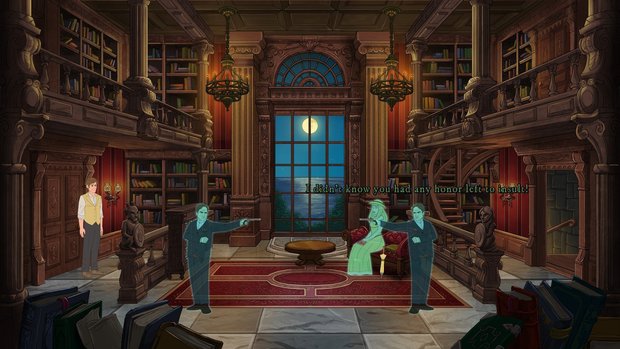
My personal favorites are likely tied between the mysterious ghost bride Abigail Bellemore and the darkly intimidating specter Rackham, both of whom evolve in unexpected ways from their initial introductions to the game’s story. But they’re all expressive when speaking, and each character is distinct in their own way. They’re enjoyable to interact with, helped in part by the outstanding voice acting all around. Headlining the cast is AJ LoCascio as Murphy McCallan, this being his first time back in the adventure gaming fold since his spot-on performance as Marty McFly in Telltale’s Back to the Future. Murphy is likeable but willing to do some less-than-honorable things to achieve his goals. But at the end of the day, he’s got a heart of gold and is really trying to do right by the people he cares about. He too matures a lot as a person throughout the story. His relationship with the inhabitants of Devil’s Rock grows in surprising ways as well, leading to an incredibly emotional finale that genuinely blew me away.
Foolish Mortals keeps things simple with regards to controls. Everything is handled with a mouse-only interface: interactions via left-clicks, examining items and environmental hotspots via right-clicks, and toggling a hotspot highlighter on and off with a click of the mouse wheel (or selectable from an icon in the upper right). Items in your inventory are available in a hidden bar at the top of the screen at all times; simply hover the cursor over it and it will appear. Alternatively, you can scroll down on the mouse wheel to display it, then scroll back up to hide it once more. Also hidden at the top right are icons to go to the main menu’s save/load screens, a quick-access island map, and Murphy’s Diary.
Murphy will walk at a slow, leisurely pace when clicking through the environments, but double-clicking will cause him to move a bit faster, and doing so on directional markers for labeled area exits will immediately teleport you to the next scene. The map lets you move between major locations instantly once they’re discovered, and the first time I opened it I audibly gasped. At first I thought I was looking at a recreation of the map of Mêlée Island, but I soon saw that the gorgeously detailed Devil’s Rock was an original locale all its own. Various events over the course of the story will cause the map to change with added elements, and to see it actually updating after switching on the island’s lighthouse or uncovering a previously inaccessible area, for example, is a treat to behold.
Foolish Mortals is split up into five parts, each with a title card depicted in a beautifully drawn black-and-white ink style. After the substantial prologue, each subsequent chapter is structured around a main goal that requires various items to be collected. The first set comprises the ingredients for a Voodoo spell to summon forth the ghosts residing at Bellemore Manor. The island slowly reveals more and more of itself to you as you track down the necessary components to fill a mystical gris-gris. This works to ease you in and ensure you don’t get overwhelmed with the abundant island locations, letting you organically familiarize yourself with the places you can explore.
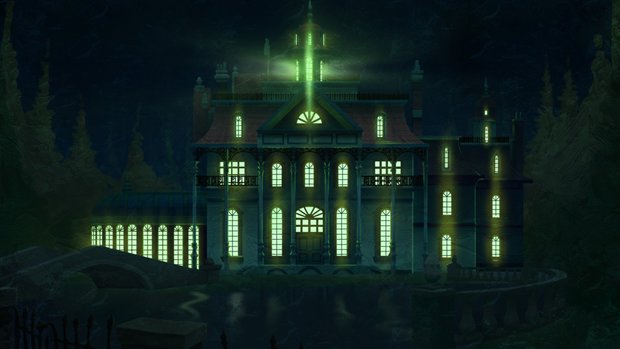
Once inside Bellemore Manor, you must search for items and talk with the ghosts who are trapped there. Most seem pretty unbothered by the whole “being dead” thing, but not all of them welcome Murphy’s presence. Later the game really opens up, allowing you to explore both the inner rooms of the mansion and the entire rest of the island to search for what you need. This gradual unfolding of locations feels natural and perfectly paced, steadily increasing from a limited number to a grander scale to solve multi-layered conundrums.
This ramping up of scale doesn't just apply to the settings, it also extends to the inventory you collect along the way. In most games, you acquire items with a single use, like a shovel to dig something up or a key to open a locked door, and then discard them immediately after. While some objects in Foolish Mortals are similarly single-use, the vast majority of them contribute to a minimum of two puzzles each. I believe the empty glass soda bottle may be one of the most useful items ever included in an adventure game. Seriously, this discarded beach garbage ends up saving Murphy’s butt in so many different ways it’s unreal. But that's not the only item used in ways that are sometimes obvious and other times much more outside-the-box, making me think of surprising solutions while keeping in mind the entirety of my inventory rather than just the most recently acquired shiny new thing.
The brain teasers here are executed with laser-focused precision, offering just enough guidance to get you going but never too much to give away the fun of figuring things out yourself. One early task I really enjoyed was to gain access to The Captains Club, where you’ll only be allowed in if you’re, well, a captain. As Murphy is not sea savvy in the slightest, you have to find more deviously creative means to pass yourself off as one. Another requires you to play a record on an old gramophone, but the horn and record are inoperable, and the solution to making music again involves multiple steps that are far more complex than you’d imagine while still being entirely logical.
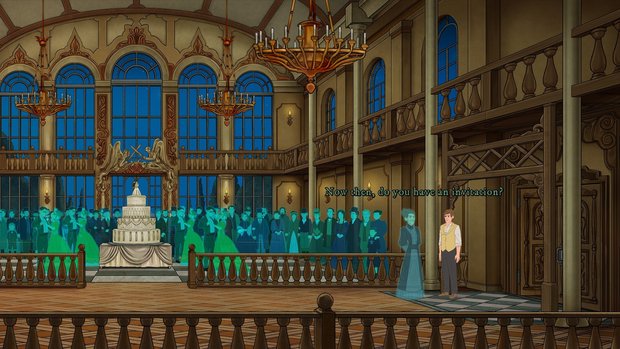
One particularly challenging puzzle involves ballroom dancers at Bellemore Manor. There are various dance moves that can be assigned to the ghostly wedding participants, but you must move them in a very specific order to achieve your goal without ever getting onto the dance floor yourself. It took me a solid thirty minutes to unravel how it all worked, but once I figured it out I experienced an “a-ha!” moment that left me feeling incredibly accomplished. There’s tons of small moments like this in Foolish Mortals, created with killer puzzle design that comes from a place of truly understanding the genre and what makes an all-timer conundrum tick.
A few other sections stumped me for a bit (I’m still not entirely sure how a particular puzzle involving an ivory comb, two flustered twin puppeteers, a magazine ad, and some silly honking was supposed to be solved without help), but whenever that happened I used the fantastic hint system in Murphy’s Diary to give myself just enough of a boost to figure out the rest on my own. It works largely like an old paper hint book, where you find the goal you’re currently struggling with and click for different tiers of hints. These are hand-written from the protagonist’s perspective as if he had already completed the task, such as Murphy saying something along the lines of, “I needed to meet with the grave keeper, so I headed for the graveyard.” Thankfully there are enough layers provided that I never had a final solution spoiled for me. The designers clearly had faith in players to work things out on their own, or to tailor the level of assistance needed according to personal preference.
Personally I sought out five or so hints during my 11-hour playtime, all of them in particularly tricky areas in the last third of the game. Foolish Mortals has a second hint system as well, this one more subtle and dynamic. If the game senses you spending too long working out a particular puzzle, Murphy will offer up a helpful suggestion to give you a nudge. This is never overdone, however, refusing to ever force-feed you answers you don’t want before you’re ready. A handful of puzzles are timed by default, but not only are they generously timed, an option in the settings allows you to remove the timer completely if you wish, in yet another nice display of user-friendliness.
Even saving the game offers quality-of-life options. There is an auto-save that updates periodically, but there’s also an unlimited number of manual save slots that can be utilized at any time when controlling Murphy. As a quirk of the game’s Visionaire engine, rather than allowing save files to be overwritten, the save function is greyed out when you click on any pre-existing file, forcing you to create a new save each time, but it’s a small issue and the two different save modes exceed what most modern adventures offer. Granted, there’s no real risk of losing progress anyway, as the game is very stable and there’s no unfair deaths or dead ends to worry about, from the beginning all the way through to its glorious finale.
Final Verdict
Foolish Mortals is truly a masterpiece in which you feel the love and dedication behind its creation every second you play. The production values are impeccable and the characters are memorable, with a story and voice cast that knock it out of the park. Every location you explore is packed with oddities that make them stand out from the rest, and I eagerly devoured every bit of detail and quip Murphy muttered about them. There’s a sense of satisfaction in just about every puzzle the game throws your way, and by the end of it all I felt like I’d been right there with Murphy uncovering a grand decades-old mystery. Add it all up and I am happy to say that Foolish Mortals is destined to become the next modern classic. A happy haunting indeed.
Hot take
Foolish Mortals is an absolute triumph. The love and respect for what makes an adventure game great is on full display in every expertly crafted scene, puzzle, piece of dialogue and quality-of-life user option throughout. If you consider yourself a fan of the genre, this is one ghostly journey that cannot be missed.
Pros
- Stunningly beautiful 2D visual presentation
- Impressive scope that never feels overwhelming
- Clever puzzle design expands on typical item use
- Fantastic story balances spooky fun with touching emotional moments
- Incredible voice cast and soundtrack
- Evokes all the best nostalgic feelings of the all-time genre classics without ever feeling derivative
Cons
- Very minor quirk with the manual save system
- Eventually it ends
Sam played Foolish Mortals on PC using a review code provided by the game's publisher.



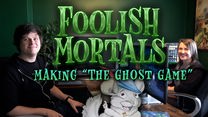
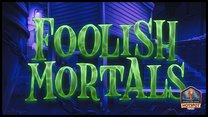






12 Comments
Want to join the discussion? Leave a comment as guest, sign in or register.
I just KNEW you'd review this one! Great job!
Reply
Thanks Johnny!! It was a blast to play through and review, can’t wait for more people to get their hands on the game and give it a go!
Reply
If this meets my standards (or perhaps 'preferences') for a 100%, then Day of the Tentacle will finally have some company at the top. Either way, I've been looking forward to this game for a while now and will play it as soon as I finish Noctropolis. Which, by the way, is not as bad as some would have you believe. Just have a walk through handy and use it only for the dialogue tree 'puzzles', aka trial and error tests of patience.
Reply
Im relatively new to the adventure game scene. How are the puzzles? This looks reminiscent of the 80s-90s adventure games (which I've never played) that many people claim have ridiculous logic behind their puzzles.
Reply
The puzzles are challenging but logical throughout, but there’s also a helpful hint system available in case you ever get stuck. No moon logic to worry about, and no dead ends to speak of either!
Reply
It’s also available on the Mac, but the game info on AGH does not state that. I’m SO happy about that. And I was SO disappointed when it first seemed it wasn’t.
Reply
So it is! Thanks. Added to the database.
Reply
I’m in the midst of Episode 2. Some general stand-out qualities to me are - how interesting the dialogs and cutscenes are - the pacing of the dialogs - how fair the puzzles feel - how fast you can get where you want to go And the Lover - Pawn - Devil puzzle song deserves a place in the All Time Point And Click Adventure Canon!
Reply
Also, the game reminds me of Voodoo Detective in various good ways. That one also deserves some attention on AGH I believe.
Reply
Definitely some similarities! We reviewed it back in 2022: https://adventuregamehotspot.com/review/21/voodoo-detective
After playing a couple of hours i wouldn't say i'm that impressed. Although the artwork is stunning, the plot is interesting, voice acting, dialogues everything seems fine but the game lacks difficulty. Puzzles are very simple, so little to no challenge. Still recommended though.
Reply
I can't speak for the level of difficulty you are used to but I can say that, as the game goes on and you spend more time playing, there's a lot more to see and it will become more challenging. The difficulty grows throughout the game.
Reply
Leave a comment